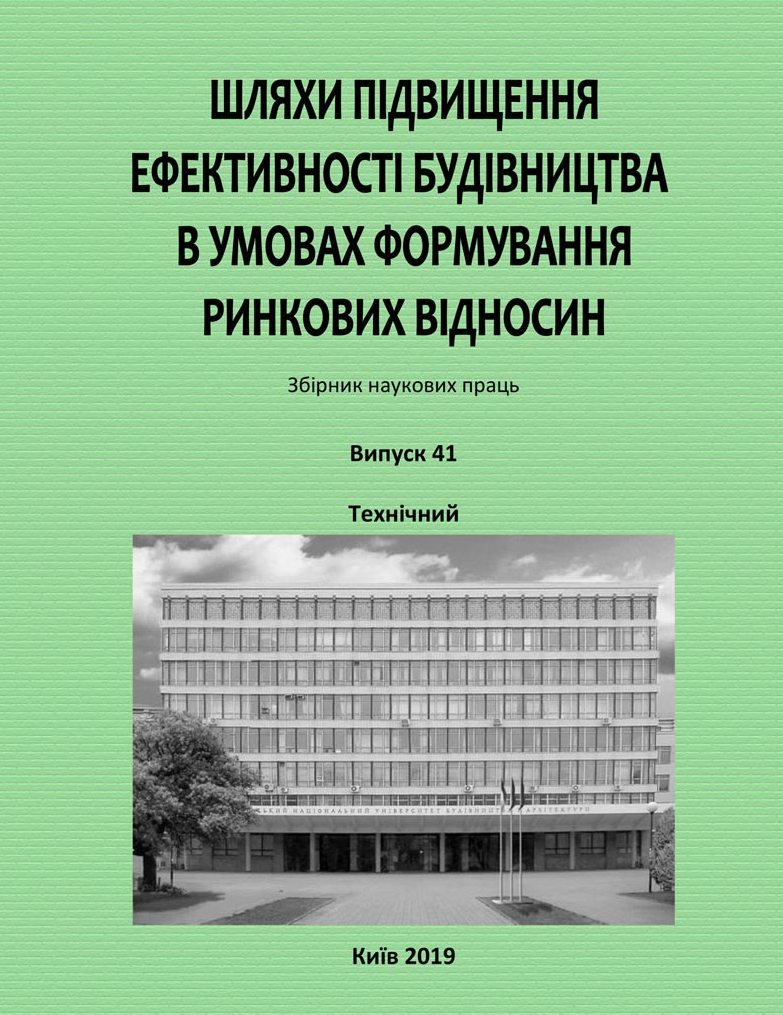Modeling of external air temperature influence on concrete parameters
DOI:
https://doi.org/10.32347/2707-501x.2019.41.163-171Keywords:
construction, modeling, reliability, construction process, concretingAbstract
The necessity of estimation by the customer of the cost of winter price increase, increase of complexity and terms of performance of certain types of works carried out in the winter is carried out. Most construction companies can successfully counteract the negative effects of natural and climatic factors in the winter by having the technological capabilities to perform construction throughout the year. But at the same time, the cost and complexity of the work is increasing, as many construction works are performed in open, unprotected space, and for their successful implementation requires additional organizational and technological measures. From this it follows the hypothesis that the deviation of the concreting parameters in winter conditions depends on the ambient temperature and the month in which the construction is conducted, these deviations can be predicted with varying degrees of accuracy, having data on average daily temperature over the previous few years or knowing the months in where concrete works are carried out.
It has been found that the effects of winter conditions at different stages of design are compounded or on the basis of similar objects. At the same time, during the execution of the JHA, there is already an opportunity to make detailed calculations. Accordingly, it can be concluded that detailed calculations of the cost and complexity of the construction works at the tender stage will allow to substantiate the increase in the parameters of construction in winter conditions.
As a result, it is found that air temperature has an average degree of influence on the construction parameters. So, for the complexity, the coefficient of determination was R2=0,5229. This means that 52.29% of the increase in complexity in the investigated observations is due to the influence of temperature.
For concreting terms, the coefficient of determination was R2=0,4994, and for the estimated cost – 0,6802. This means that 49.9% increase in terms and 68% increase in estimated cost in the investigated observations is due to the influence of temperature.
Taking into account the increase in cost of money, labor and time of completion of concreting works in winter is not by normative coefficients, but on the basis of the contractor-based base of similar objects will allow the contracting companies to more reasonably calculate the terms of work, their complexity and labor.
References
Zeltser, R.Ia., Bielienkova, O.Yu. & Dubinin, D.V. (2018) Innovatsiini modeli i metody orhanizatsii, upravlinnia i ekonomichnoi otsinky tekhnolohichnykh protsesiv budivelnoho vyrobnytstva : Monohrafiia. – K.: «MP Lesia».
Bielienkova, O.Yu. (2015) Vplyv sezonnykh kolyvan na oborotni aktyvy budivelnoho pidpryiemstva. Investytsii: praktyka ta dosvid. № 19.48 – 53.
Hoiko, A.F. & Skakun, V.A. (2009) Skakun Stratehichne upravlinnia lohistychnymy biznes-protsesamy budivelnykh pidpryiemstv: priorytetni zadachi ta shliakhy yikh vyrishennia: Kommunalnoe khoziaistvo horodov. 87. 172-178.
Husakov, A.A., Veremeenko, S.A., Hynzburh, A.V. (1994) Orhanyzatsyonno-tekhnolohycheskaia nadezhnost stroytelstva. M.: SvR, Arhus.
Dubinin, D.V. (2015) Prohnozuvannia resursnykh potokiv budivelnoho pidpryiemstva. Suchasni tekhnolohii ta metody rozrakhunkiv u budivnytstvi. 3. 74-78.
Zeltser R. Ya., Dubinin D.V. Udoskonalennia systemy keruvannia informatsiieiu budivelnoho pidpryiemstva //D.V.Dubinin// Budivelne vyrobnytstvo – 2015. – Vyp. 57.
Izmailova, K. V., Izmailova O.V. (2010) Systema ekspertyzy efektyvnosti investytsiinykh na stadii tekhniko-ekonomichnoho obgruntuvannia. Upravlinnia rozvytkom skladnykh system. 4. 45-54.
Tuhai, O.A. (2009) Peredumovy ta analitychni osnovy zaprovadzhennia innovatsii v orhanizatsiino-tekhnolohichne modeliuvannia pidhotovky budivnytstva. Mistobuduvannia ta terytorialne planuvannia. 35. 449-458.
Tytok, V.V. (2013) Formuvannia modeli zhytlovoho budivnytstva v misti. Shliakhy pidvyshchennia efektyvnosti budivnytstva v umovakh formuvannia rynkovykh vidnosyn. 30. 90-98.
Ushatskyi, S.A. (2003) Systemno-upravlinski ta inzhynirynhovi zasady vprovadzhennia innovatsii v orhanizatsiiu budivnytstva//Monohrafiia.-K.:Naukovyi svit.
Tuhai, O.A. & Stetsenko, S.P. (2012) Modernizovani instrumenty developerskoho upravlinnia budivnytstvom. Shliakhy pidvyshchennia efektyvnosti budivnytstva v umovakh formuvannia rynkovykh vidnosyn. 27/1. 86-98.
Zmina №1 DBN A2.2-3:2014 «Sklad ta zmist proektnoi dokumentatsii na budivnytstvo»/ URL: https://dbn.co.ua/load/normativy/dbn/dbn_a_2_2_3_2014/1-1-0-1168
Tugai, O. A., Hryhorovskyi. P. Ye., Khyzhniak, V. O., Stetsenko, S. P., Bielienkova, O. Yu., Molodid, О. S., Chernyshev, D.O. (2019) Organizational and technological, economic quality control aspects in the construction industry : collective monograph – Lviv-Toruń : Liha-Pres.
Zeltser, R.Ya., Bielienkova, O.Yu., Novak, Ye., Dubinin D.V. (2019) Digital Transformation of Resource Logistics and Organizational and Structural Support of Construction. Nauka i innovatsii. V 15(5), pp. 38-51
Stetsenko, S.P., Bielienkova, O.Yu., Lytvynenko, O.V. (2017) Vplyv sezonnykh kolyvan na vartisni parametry budivelnoho vyrobnytstva. Upravlinnia rozvytkom skladnykh system. 32. 179 ––185
Downloads
How to Cite
Issue
Section
License
Copyright (c) 2020 E. Novak

This work is licensed under a Creative Commons Attribution 4.0 International License.
Authors who publish with this journal agree to the following terms:
- Authors retain copyright and grant the journal right of first publication with the work simultaneously licensed under a Creative Commons Attribution License that allows others to share the work with an acknowledgement of the work's authorship and initial publication in this journal.
- Authors are able to enter into separate, additional contractual arrangements for the non-exclusive distribution of the journal's published version of the work (e.g., post it to an institutional repository or publish it in a book), with an acknowledgement of its initial publication in this journal.
- Authors are permitted and encouraged to post their work online (e.g., in institutional repositories or on their website) prior to and during the submission process, as it can lead to productive exchanges, as well as earlier and greater citation of published work (See The Effect of Open Access).

